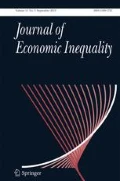Abstract
Atkinson et al. (J. Econ. Lit. 49(1):3–71, 2011) survey an important new literature using income-tax-based data to measure the share of income held by top income groups. But changes in tax legislation that expand the tax base to include income sources (e.g. capital gains, dividends, etc.) disproportionately held by these groups will conflate such an expansion with an increase in the share of income they hold. We provide a cautionary tale from Australia of how comprehensive tax reform legislation in 1985 substantially altered Australian top income series, especially those that do not separate taxable realized capital gains from other taxable income. Drawing on the Household, Income and Labour Dynamics in Australia (HILDA) Survey we then estimate the size and distribution (across income groups) of taxable realized capital gains in 2006 and 2009, and compare these results with those using accrued capital gains, finding substantially different distributions. More importantly, we find substantial differences across our measures in how capital gains changed between 2006 and 2009. Our results suggest that yearly taxable realized capital gains, often included in studies of top incomes, might be a poor proxy for the theoretically more appropriate yearly accrued capital gains.
Similar content being viewed by others
References
Aaberge, R., Bjorklund, A., Jantti, M., Pedersen, P.J., Smith, N., Wennemo, T.: Unemployment shocks and income distribution: How did the nordic countries fare during their crises? Scand, J. Econ. 102 (1), 77–99 (2000)
ABS (Australian Bureau of Statistics): Australian System of National Accounts, 2011-12: Table 36. Household Income Account, Current Prices, Catalogue No. 5204. 0 (2012)
ABS (Australian Bureau of Statistics): House Price Indexes: Eight Capital Cities, Catalogue, No. 6046.0 (2013)
Alvaredo, F., Atkinson, A.B., Piketty, T., Saez, E.: The World Top Incomes Database. http://g-mond.parisschoolofeconomics.eu/topincomes/ Cited 31 May 2014 (2014)
Armour, P., Burkhauser, R.V., Larrimore, J.: Deconstructing income inequality measures: A crosswalk from market income to comprehensive income. Am. Econ. Rev. 103 (3), 173–177 (2013)
Armour, P., Burkhauser, R.V., Larrimore, J.: Levels and trends in United States income and its distribution: a crosswalk from market income towards a comprehensive Haig-Simons income measure. Southern Econ J. (in press)
Asprey, K., Lloyd, J., Parsons, R., Wood, K.: Taxation Review Committee Full Report. Australian Government Publishing Service. Canberra (1975)
Atkinson, A.B., Leigh, A.: The distribution of top incomes in Australia. Econ. Rec. 83 (262), 247–261 (2007)
Atkinson, A.B., Leigh, A.: Top incomes in New Zealand 1921-2005: Understanding the effect of marginal tax rates, migration threat, and the macroeconomy. Rev. Income Wealth 54 (2), 149–165 (2008)
Atkinson, A.B., Piketty, T., Saez, E.: Top incomes in the long run of history. J. Econ. Lit. 49 (1), 3–71 (2011)
Auerbach, A.J.: Capital Gains Taxation and Tax Reform. Natl. Tax J. 42 (3), 391–401 (1989)
Australian Government: Reform of the Australian Tax System: Draft White Paper. Australian Government Publishing Service. Canberra (1985)
Barthold, T.: How should we measure distribution. Natl. Tax J. 46 (3), 291–99 (1993)
Burkhauser, R.V., Hahn, M.H., Wilkins, R.: Measuring top incomes using tax record data: A cautionary tale from Australia. NBER Working Paper 19121 (2013)
Commissioner of Taxation: Australian Taxation Office: Taxation Statistics 1971-72 to 2010-11. Australian Government Publishing Service, Canberra (1973-2013)
Feenberg, D.R., Poterba, J.M.: Income inequality and the incomes of very high-income taxpayers: evidence from tax returns. In: Poterba, J. (ed.) Tax Policy and the Economy, vol. 7, pp. 145–77. MIT Press, Cambridge (1993)
Fjærli, E., Aaberge, R.: Tax Reforms, Dividend Policy and Trends in Income Inequality: Empirical Evidence Based on Norwegian Data. Statistics Norway Discussion Paper No. 284 (1999)
Handley, J.C., Maheswaran, K.: A measure of the efficacy of the Australian imputation tax system. Econ. Rec. 84 (264), 82–94 (2008)
Keating, P.: Reform of the Australian Taxation System: Statement by the Treasurer. Australian Government Publishing Service. Canberra (1985)
Morelli, S., Smeeding, T., Thompson, J.: Post-1970 trends in within-country inequality and poverty: Rich and middle income countries. In: Atkinson, A.B., Bourguignon, F. (eds.) Handbook of Income Distribution, vol. 2. Elsevier, North Holland (in press)
Piketty, T.: Income inequality in France 1901-1998. J. Polit. Econ. 111 (5), 1004–1042 (2003)
Piketty, T., Saez, E.: Income inequality in the United States, 1913–1998. Q. J. Econ. 118 (1), 1–39 (2003)
Reinhardt, S., Steel, L.: A brief history of Australia’s tax system. Paper presented at the 22nd APEC Finance Ministers’ Economic Roundup, Winter, pp. 1–16. Australian Government—The Treasury (2006)
Roine, J., Waldenstrom, D.: The evolution of incomes in an egalitarian society: Sweden, 1903-2004. J. Public Econ. 92, 366–387 (2008)
Roine, J., Waldenstrom, D.: Common trends and shocks to top incomes: A structural breaks approach. Rev. Econ. Stat. 93 (3), 832–846 (2011)
Roine, J., Waldenstrom, D.: On the role of capital gains in Swedish income inequality. Rev. Income Wealth 58 (3), 569–587 (2012)
Roine, J., Waldenstrom, D.: Long run trends in the distribution of income and wealth. In: Atkinson, A.B., Bourguignon, F. (eds.) Handbook of Income Distribution, vol. 2. Elsevier, North Holland (in press)
Slemrod, J.: High income families and the tax changes of the 1980s: The anatomy of behavioural response. In: Feldstein, M., Poterba, J. (eds.) Empirical Foundations of Household Taxation. University of Chicago Press, Chicago (1996)
Watson, N., Wooden, M.: The HILDA survey progress and future developments. Aust. Econ. Rev. 43 (3), 326–336 (2010)
Wooden, M., Watson, N.: The HILDA survey and its contribution to economic and social research (so far). Econ. Rec. 83 (261), 208–231 (2007)
Author information
Authors and Affiliations
Corresponding author
Rights and permissions
About this article
Cite this article
Burkhauser, R.V., Hahn, M.H. & Wilkins, R. Measuring top incomes using tax record data: a cautionary tale from Australia. J Econ Inequal 13, 181–205 (2015). https://doi.org/10.1007/s10888-014-9281-z
Received:
Accepted:
Published:
Issue Date:
DOI: https://doi.org/10.1007/s10888-014-9281-z



